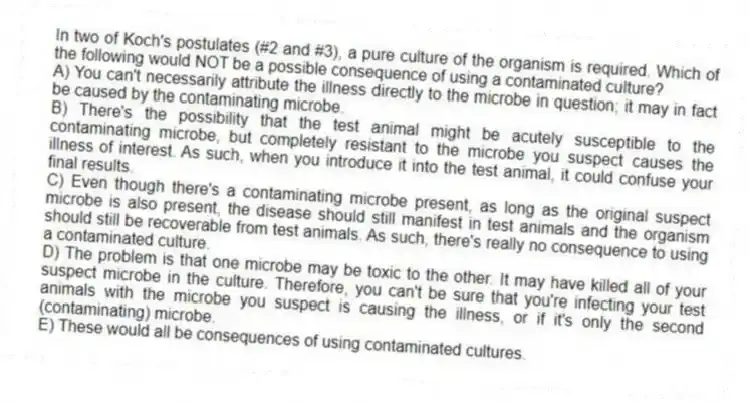
In two of Koch's postulates (#2 and #3) , a pure culture of the organism is required. Which of the following would NOT be a possible consequence of using a contaminated culture?
A) You can't necessarily attribute the illness directly to the microbe in question; it may in fact be caused by the contaminating microbe.
B) There's the possibility that the test animal might be acutely susceptible to the contaminating microbe, but completely resistant to the microbe you suspect causes the illness of interest. As such, when you introduce it into the test animal, it could confuse your final results.
C) Even though there's a contaminating microbe present, as long as the original suspect microbe is also present, the disease should still manifest in test animals and the organism should still be recoverable from test animals. As such, there's really no consequence to using a contaminated culture.
D) The problem is that one microbe may be toxic to the other. It may have killed all of your suspect microbe in the culture. Therefore, you can't be sure that you're infecting your test animals with the microbe you suspect is causing the illness, or if it's only the second (contaminating) microbe.
E) These would all be consequences of using contaminated cultures.
Correct Answer:
Verified
Q57: The chemical nature of exotoxins is that
Q58: A strong attachment of a microorganism to
Q59: Only Gram-positive bacteria produce exotoxins.
Q60: Bacteria may survive phagocytosis by
A) preventing fusion
Q61: Please select the CORRECT definition regarding interactions
Q63: Which of the following is NOT a
Q64: Why is it not possible to use
Q65: Please select the correct definition of balanced
Q66: A number of viruses often include a
Q67: Jay tells you that he ate chicken
Unlock this Answer For Free Now!
View this answer and more for free by performing one of the following actions

Scan the QR code to install the App and get 2 free unlocks

Unlock quizzes for free by uploading documents